MV Kalakala
History of 'The Flying Bird' - The Kalakala
The unusual name comes from the Chinook (Native American Indian) Tribe language

The Chinook Tribal Flag - an striking combination of shapes and colour which can easily be seen in the Kalakala design.
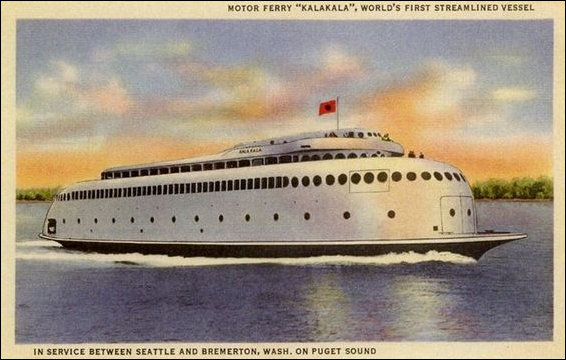
The Kalakala has a rich and wonderful history which is painstakingly chronicled on a website dedicated to this marine phenomenon which looks like a cross between a lozenge and 'Stingray' (or more to the point, might 'Stingray' have been based on the Kalakala?). I do want to add some of the information to this page and also to showcase the 1930s artwork and promotion of the Kalakala but its history does not deserve to be diluted - I will use information only to enhance the imagery.
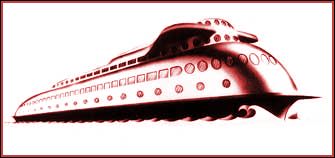
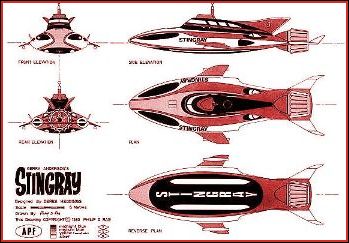
Now that I've had my little bit of fun with the Kalakala/Stingray comparison it is time to settle down to some more serious (but not boring) information about this unique design.
One of the things that the Kalakala lends itself to is the artwork that can come from it whether advertising its origins or using it as a campaign tool or creating a storyboard for its demise, the Kalakala always stands proud.
Meet the Kalakala

As advertised by the Puget Sound Navigation Co.
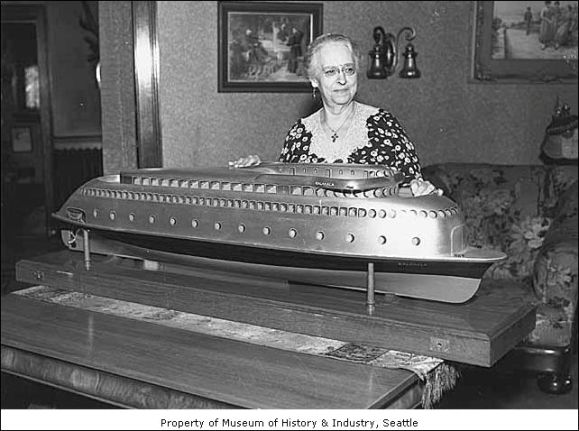
Model (with Mrs Peasbody) courtesy of Open Architecture Network - Mrs Peasbody is reputed to have stated 'She ought to be more rounded!' as the model was displayed on her dining table as a result the design was radically altered to become the World's First Streamlined Vessel.
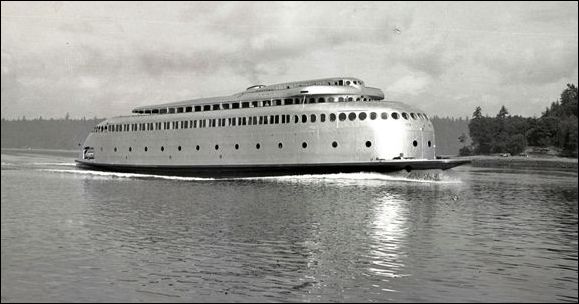
The Kalakala in all her glory as the world's first streamlined vessel.

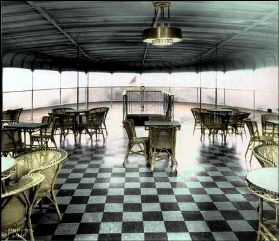
Bar and Coffee Lounges, as with many 1930s interiors, resembling the Hollywood Movie sets of the time
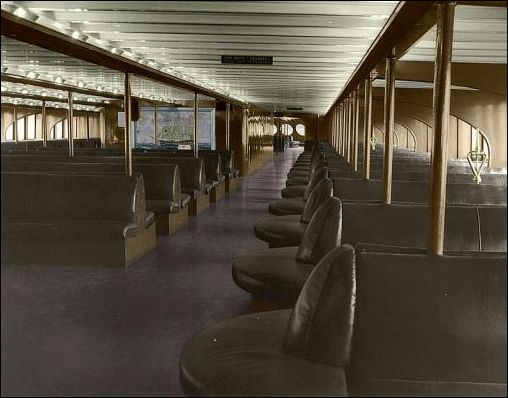
Original images courtesy of the Open Architecture Network
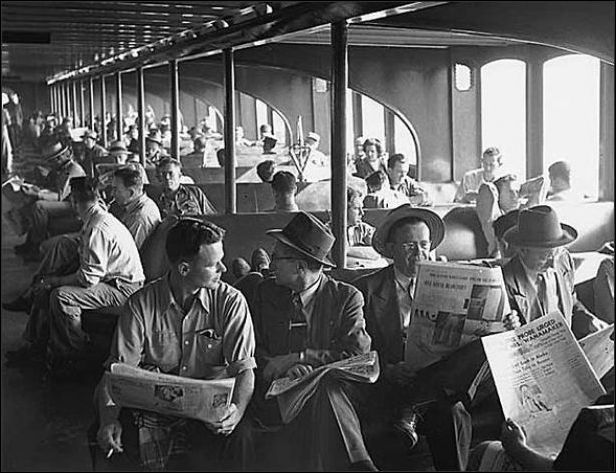
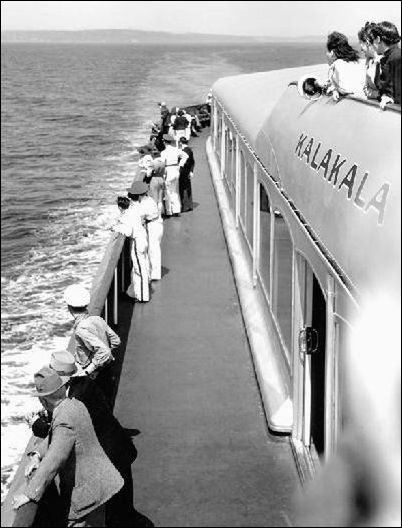
Passengers enjoying the comforts of the Kalakala inside and on the deck
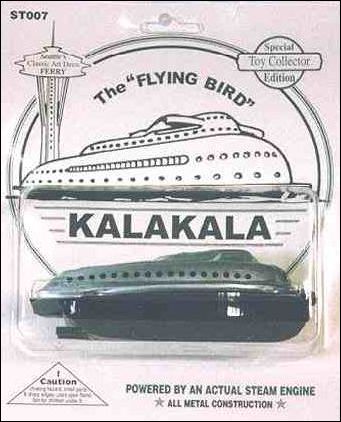
Who wouldn't want a model of their own of the Kalakala?
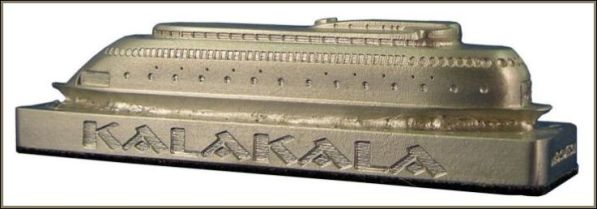
Still selling today on Replica Buildings
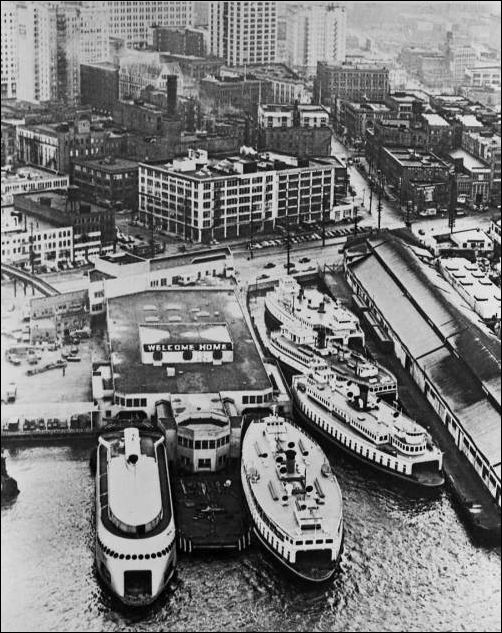
Berthed and welcomed home after a safe return from War duties - image courtesy of DorpatSherrardLomont
Weird Washington
This web-site carries a nice tribute to the Kalakala
The Unlucky Flight of the Kalakala
One of the wonderful sights in the Puget Sound in the early twentieth century was the Art Deco sculpture-like passenger ferry, the Kalakala. The Kalakala sailed the waters of the Puget Sound between Bremerton and Seattle from the 1930s to the 1960s. She left the Sound in the 1960s, only to return like a ghost in the 1990s. The Kalakala began its existence in 1927 San Francisco as the Peralta: a passenger and auto drive-on, drive-off ferry. It was open at both ends, and cars drove on board, headed to the far end of the ship, and parked.
When the ship docked, the cars simply drove off the front of the ferry, rather than backing off. To prevent sinking as the weight shifted with the cars, the Peralta had a series of trim tanks at either end, which acted as ballast. When the cars unloaded at one end, the tank at the other end filled with water, keeping the ferry on an even keel. Some suspected from the beginning that the ferry was bad luck. During her launch, the Peralta got stuck in the launching ramp. To old salts, this was a sign that the ship was jinxed. And it seemed to follow on February 14, 1928, when the ferry crew filled the wrong trim tank. As the passengers unloaded, the docking end of the Peralta sunk. Waves swept over the landing ramp, and many passengers went overboard. Five people drowned.
Another disaster struck the ship the night of May 6, 1933. The Peralta was docked at the Oakland ferry terminal, which caught fire. The fire spread to the ferry, and by morning, the upper decks were burned and twisted. Only the hull remained intact beneath the waterline. The Puget Sound Navigation Company bought the remains of the ferry for $10.00 and towed her to the Lake Washington shipyards, where they rebuilt the superstructure. And rather than just rebuild a functional ferry, they decided to incorporate Art Deco features and aerodynamic stylings into its design. A Boeing employee carved a wooden model that the shipwrights used as a template. They welded aluminium and steel plates together on the new superstructure and painted it silver. The end result looked like airplane without wings (or a giant floating toaster). Even the new name fit the design: Kalakala is from the Chinook language and means, “fast flying bird.”
The Kalakala certainly seemed fly. She was the fastest ferry in the Puget Sound, making eight round trips between Bremerton and Seattle every day at a brisk eighteen knots an hour. It had room for 110 autos on her car deck. The remaining decks had room for 2,000 passengers. There were shower facilities for shipyard workers returning home, a lunch counter, three observation rooms, a sun deck and a ladies’ lounge. It became a hot nightspot. The lunch counter catered parties and the observation deck became a ballroom. Despite the ferry’s rebirth, bad luck seemed to dog her new incarnation. The Kalakala’s distinctive design had serious drawbacks. The crew in the pilothouse had a hard time seeing where she was going. She ran into other ships and the ferry docks several times over the years. And sadly, at least one woman committed suicide in the Ladies’ Lounge.
Despite this, the Kalakala was a Seattle icon for decades, until she was simply too old to serve. Her engines needed an expensive overhaul, and by 1967, the increasing size of cars made it impossible to fit more than 60 cars on the car deck. At the same time, fewer passengers travelled on foot. The Kalakala’s owners decided to sell her that year, and a fishing company bought her and towed her to Alaska. She spent over 30 years there as a floating fish processor and cannery.
In 1998, Seattle sculptor Peter Bevis and the Kalakala Alliance Foundation purchased the ferry and towed her to the Puget Sound. They had plans to restore her, but the Kalakala’s bad luck seemed to follow, as the Foundation went bankrupt in 2003.
Even after a private buyer purchased her rusting bulk in 2004, she continued to be unlucky. She was towed to Neah Bay, where the Makah Indians had donated moorage, but she damaged one of their docks and they sued (but dropped it in 2006). Another buyer purchased her and she’s been moored in Tacoma since October 2004. Today, the Kalakala Alliance Foundation has plans to fully restore the Kalakala. They’ve obtained state and national historic registrations and created a new master plan that places her in a park called “Columbia Gardens,” located in Tacoma. Perhaps the fast flying bird has really come home to roost this time.
Kalakala Ghosts
In 2001, Ross Allison, President of the Advanced Ghost Hunters of Seattle, Tacoma (AGHOST,) noticed the Kalakala, and contacted Peter Bevis. He asked if the ferry was haunted, and Bevis had a few tales to share with Allison, including a story from when the ferry was towed back to the Puget Sound in 1998.
The trip back took several days, and Bevis and several workmen he hired to help stayed on board during it. Bevis slept near the Ladies’ Lounge. Several times, he heard women talking and laughing, which at first he attributed to a nearby cannery. One night he heard what sounded like three women talking as they walked along the companionway outside his quarters.
He put on his shoes, grabbed a flashlight and then followed the sounds of the conversation. He trailed the sound down the next two decks, catching up at the foot of a spiral staircase. He could hear women giggling there, but could not see anyone. Then, the sounds stopped abruptly. Bevis thought this ghostly manifestation might have had something to do with a passenger from 1940 named Adelaide Bebb. She had recently lost her father and sister in a car crash, and was not married (practically a tragedy itself in those days). Unable to cope, she shot herself in the Ladies’ Lounge.
In 2002, AGHOST and the Washington State Ghost Society toured the Kalakala with Bevis. Some of the sensitives in the group felt drawn to the Ladies’ Lounge and a female psychic detected the spirit of a woman who did not like men.
Other investigators brought devices that measured electromagnetic energy, which detected energy readings in the Ladies’ Lounge. The investigators set up motion detection sensors and energy detectors, connected to a computer that recorded all of the readings at the same time. They left the Lounge and investigated other locations on the ferry, where they got more energy readings that coincided with the presence of the sad female spirit. When the psychic detected the spirit, the meters around her went off. As the technicians moved forward, the energy went down. The psychic moved, following the spirit, and the energy readings rose. The psychic suggested that the spirit moved away because the technicians were men, and she did not want them nearby. When they returned to the Ladies’ Lounge, they had surprising results. The motion detectors worked by emitting low-level noises that bounced off of the walls. If someone stepped in front of the emitter, the signal bounced back too soon, telling the computer something had stepped inside the room. The motion detectors spiked several times while the investigators were away. Oddly, the computer indicated one of the sounds took too long to bounce back from the wall. The only way this could have happened was if the walls of the Kalakala had moved further away from the sensor.
Ross Allison speculated that the sound emitted by the sensor may have travelled out to the wall and back, but passed through something that was not solid; something that slowed down the sound waves long enough to trip the sensors. Unfortunately, they were not able to return for more investigations.
Kalakala Haunted (?)
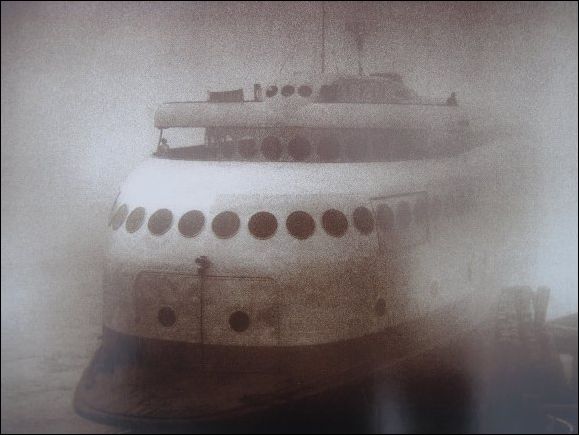
Emerging from a ghostly mist (?) - from a fun web-blog
The Kalakala never fails to deliver!
Campaigning to save the Kalakala
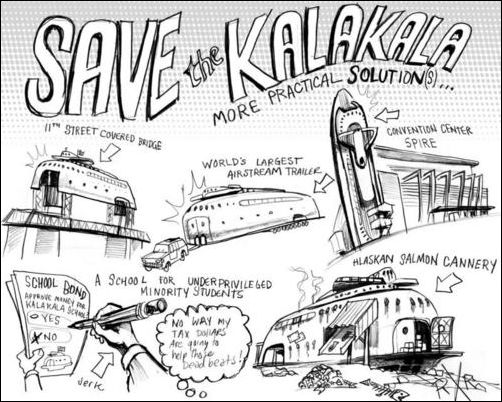
Artwork courtesy of Comics Feedtacoma
The Beginning of the End

Slowly becoming a rust bucket - image courtesy of Steve Rodrigues
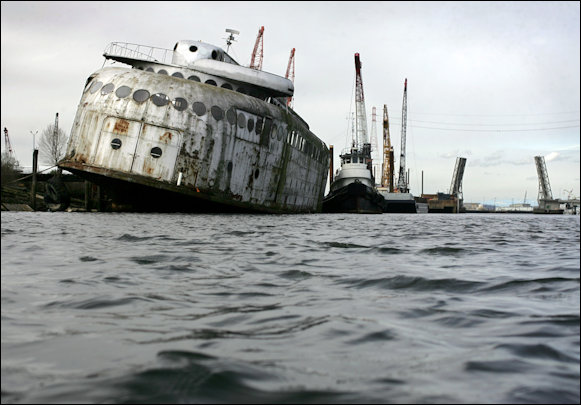
The 276-foot ferryboat Kalakala lists in its mooring on the Hylebos Waterway in Tacoma on Thursday - image courtesy & © of the Associated Press via spokesman.com
From Spokesman.com - 28th March 2011:
Art deco ferry sinking, but owner still buoyant
Neighbour calls 76-year-old boat a 'menace'
TACOMA – Steve Rodrigues’ dream for the MV Kalakala is starting to look more and more like a nightmare. The old 1935 ferryboat, famous for its streamlined, art deco design and tied up in Tacoma’s Hylebos Waterway for the past 6 1/2 years, is taking on water, causing it to list precariously and raising concerns that it’s about to sink.
“It’s a disaster waiting to happen,” said Jeff Barney, Bay Patrol director at the environmental watchdog group Citizens for a Healthy Bay. Barney, who patrols Commencement Bay and the tideflats, tracking down pollution, said that at low tides last week, the 276-foot ferry has been listing more than 25 degrees – enough to put openings in its hull below the water line.
“Every time she grounds out, she breaks off pilings and lists farther to the port side and then takes on sea water,” he said. Water pours in the holes, Barney said, until the rising tide floats the boat again and rights it – at a constantly lower level.
“I’m throwing up the red flags,” Barney said. “It’s taking on an immense amount of water. It’s time to do something, before this becomes a multi-multimillion-dollar cleanup problem.” Rodrigues, who bought the ferry in 2003 for $135,560 and has championed several creative ideas for restoring and marketing it – including restaurants, a carousel and an ice-skating arena – says the boat is not going to sink. “We’re going to have it righted again in a matter of hours,” he said Friday. Rodrigues and another man were at the dilapidated dock, sliding a large pump onto the steeply sloped deck of the Kalakala along a cable tied off to an abandoned feed storage silo on shore.
Electric power to the boat was provided by a string of extension cords running along the remains of the dock. “We have a lot of plans,” Rodrigues said. According to the corporation registry at the secretary of state’s office, Rodrigues’ nonprofit foundation, The Kalakala Alliance Foundation, which he’s been using to try to raise money to save the boat, became inactive Jan. 31. Rodrigues has estimated costs for renovation at $14 million. The U.S. Coast Guard was at the dock on Friday, too, trying to assess the risk. “We’re here to see if there is a structural integrity issue with the hull, “ Chief Warrant Officer Tim Macon said. “The question is: Is it going to sink?” Barney and other environmentalists say that if the Kalakala sinks, it will release decades worth of fuel and hazardous chemicals into the Hylebos Waterway.
The Kalakala is connected to shore at its stern with a single, frayed, 2-inch rope. Several of the pilings holding its bow are split or broken. Last month, Barney said, a cluster of pilings to which the Kalakala had been attached broke off and floated down the waterway. Marki Allen, an employee of Tri Pak Inc., which leases upland property immediately adjacent to the Kalakala, says she’s run out of patience with Rodrigues and his dreams, which she sees as farfetched and unrealistic. “I believe in preserving our past and antiques and stuff,” she said, “but this thing is just a menace right now. It’s rusting right into Puget Sound. It’s crap.”
Final Journey
End of the line: Kalakala headed to scrap yard at end of January
Originally published January 5, 2015 at 9:29 pm | Updated January 6, 2015 at 2:55 pm
The reluctant owner of the former state ferry Kalakala said he plans to scrap the art-deco boat by the end of the month, giving the 1927-vintage vessel a “death with dignity.” “I just can’t sit here and watch it deteriorate any further,” said Tacoma industrialist Karl Anderson, who took over ownership of the vessel in 2012 after the boat’s previous owner failed to pay rent. Anderson’s plans would drop a final curtain on a succession of ill-fated efforts to restore the streamlined ferry increasingly regarded as more eyesore than icon, and which in 2011 was declared by the Coast Guard to be a hazard to navigation. The 276-foot vessel, which plied Washington waters from the 1930s to the 1960s, has been moored in Tacoma since 2004, after failed attempts to restore it in Seattle, and a brief period in Neah Bay, Clallam County. Anderson said the Kalakala will be towed — on a calm day, because of its fragile condition — about a mile to another Tacoma dock where “a giant excavator will bite off a chunk of it at a time and haul them to a scrap yard.”
“It’s had no maintenance in 50 years. Anything of value was stripped out of it a very long time ago,” said Anderson, senior vice president of Concrete Technology Corp. Anderson said he has paid about $500,000 to keep the boat protected and afloat, and likely will pay that much again to have it dismantled. He said he doesn’t know what its value would be as scrap. Anderson said he made the Tacoma moorage available a decade ago to the Kalakala’s owner at the time, Steve Rodrigues, of Thurston County.
“He had a lot of plans, but nothing materialized,” Anderson said. Anderson said Rodrigues didn’t comply with terms of the moorage or Coast Guard requirements to maintain the vessel safely, and the boat was taken over by Tacoma Industrial Properties, of which Anderson is treasurer. Anderson said he no longer knows how to contact Rodrigues. The Kalakala, likened in appearance to a floating toaster or Airstream Trailer, was unique among Washington ferries. Although it had a certain charm, it often was criticized as being difficult to handle, and subject to heavy vibrations.
After being taken out of service, it was beached in Kodiak, Alaska, and used as a fish cannery. In 1998, Seattle artist Peter Bevis mounted a successful campaign to return the vessel to Seattle, but fundraising efforts for its restoration fell short. Asked if he views the Kalakala’s impending end as the death of a dream, Anderson said, “The dream died a long time ago, when the state didn’t sell it to someone who could preserve it.” Source : Seattle Times
Kalakala about to be scrapped
By C.R. Roberts - Staff writer
The final voyage of the ferry Kalakala — 2.5 miles to the site along Tacoma’s Blair Waterway where it will be demolished — is expected to begin before dawn Thursday. Moored along the Hylebos Waterway for 10 years, the boat will be towed with the tide early to a graving dock where it will be scrapped. The Kalakala first found notoriety in California as the sadly fated Peralta, which burned to the waterline and was rescued by the owner of a Washington ferry line. It was towed to Lake Washington where it was refitted with a shiny, unique, iconic, Art Deco superstructure. It served the waters of Puget Sound until being retired and repurposed as a seafood-processor both on sea and aground in Alaska. Efforts to save and restore her have failed.
“This is where it’s going to die,” said Paul Zankich, principle naval architect with Columbia-Sentinel Engineers.
The move: Because of the fragile nature of the hull, officials planned to let the tide do much of the work in gently delivering the Kalakala through the Hylebos into Commencement Bay and down into the Blair. Two tugs operated by Quigg Brothers Inc., Ironman and Fury, will escort the ferry from the Hylebos to the Blair. The first tug tied on Wednesday. Mooring lines to the Kalakala were to be removed between 3 and 5 a.m. Officials were to notify the bridge tender at 11th Street to raise the bridge, and the boat should pass through soon thereafter. Generators on board the ferry will continue to power the pumps should the hull begin to take on water. The tugs are expected to make 2.5 knots on a journey that should last just over an hour, depending on the weather.
The weather: Expected to be relatively calm, with little fog. Fog will not deter the move, although a wind-borne rough chop could.
Security: The U.S. Coast Guard will enforce a 100-yard safety perimeter around the Kalakala and the tugs
Arrival: Should occur before 6 a.m. The gate to the graving dock (like a dry dock, but simply a water-level hole in the ground) will be opened to accommodate the Kalakala and the two tugs. The tugs will position the Kalakala bow-first and guide it into place.
Tied up: The gate to the graving dock should be reinstalled by 6:30 a.m. after the tugs depart and following an inspection by divers. As water is pumped from the graving dock, the Kalakala is expected to hit bottom, and begin to list, about 7:30 a.m. Crews will remove the generators, sensors and other equipment from the Kalakala.
Next: After the water is drained, crews will “de-fish” the water remaining and return any fish to the waterway. Any rainwater that collects at the bottom of the graving dock will be collected and tested for toxins. Deconstruction of the boat might begin as early as Friday. Material derived from the Kalakala will be taken by truck to a local scrap yard.
Viewing: Difficult. The graving dock and the original mooring site are on private property and off limits to the public. Nearby industrial properties are also private. There might be room to view the Kalakala as it passes the bridge at 11th Street. And besides that, it will be dark.
Souvenirs: All salvage will be done by Tacoma-based Rhine Demolition. Any decisions about offering souvenirs to the public will be made after the demolition process, Rhine President Joel Simmonds said Tuesday. Source : Olympian and Part II
Note: Some images of the final demise are available - is everyone shamed that the Kalakala did not survive - the only existing and very interesting website has a final entry on their home page with the 80th anniversary .....
The West Seattle Herald chronicles the final hours -
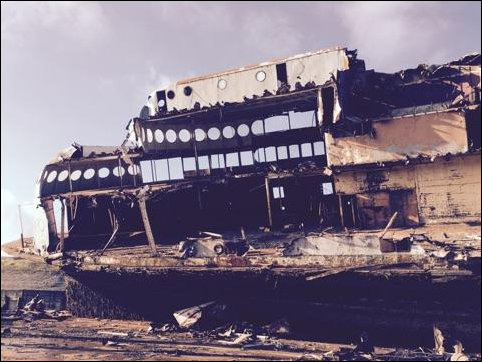
Photo by Gerry Kingen
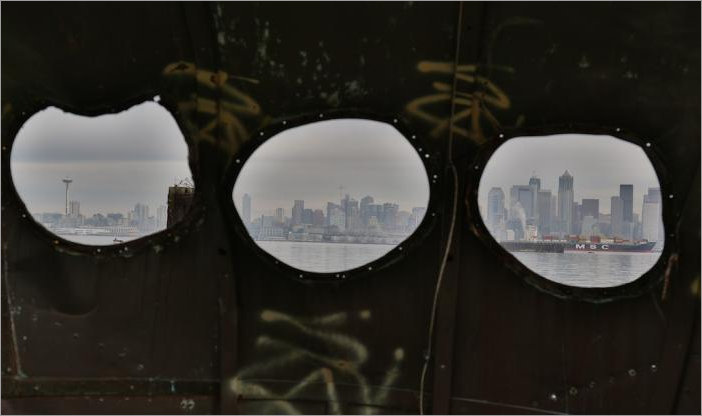
The skyline view through the portholes of the MV Kalakala. The famous ferry was dismantled on a dry dock in Tacoma in late January but will live on, at least in parts that will be on permanent display at Salty's Seafood Grill in West Seattle.
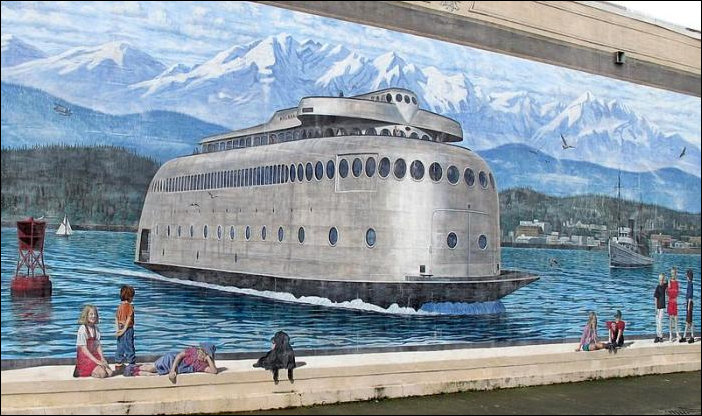
A painted mural of the MV Kalakala on a wall in Port Angeles.
The MV Kalakala comes to Salty’s on Alki
Famous art deco era ferry parts will be on permanent display in West Seattle
By Patrick Robinson | 02/11/2015
Possibly the most famous ferry to ever sail the waters of Puget Sound, the art deco era MV Kalakala, after years of service and even more in moorage has found a final place in West Seattle at Salty’s on Alki. The ferry was scrapped in a Tacoma dry dock in late January. Salty’s owner Gerry Kingen bought the parts, which have been placed at the north end of the Salty’s parking lot on both east and west sides with the stern, and rudder assembly facing out to Elliott Bay, and other parts on facing Harbor Ave. SW. Kingen has plans in place to incorporate these and other parts into the design of a 12 to 15 room boutique hotel he plans to build on the Salty’s site in the next 3 to 5 years. The existing concrete and rebar pieces that are in the location were moved to fit the ferry pieces, by Ness Cranes who did the work on Tuesday Feb. 10.
The Kalakala was built in 1926 and sailed on Puget Sound from 1935 until her retirement in 1967. The streamlined design was typical of the art deco era and the ferry was popular with residents and visitors alike. During the 1962 Seattle World’s Fair the Kalakala was voted second only to the Space Needle as an attraction. She was originally called the Peralta and served in San Francisco but in 1933 the Peralta burned, completely destroying her superstructure. With the hull still intact the vessel was sold to the Puget Sound Navigation Company (PSNC), also called the "Black Ball Line" the subject of a famous Bing Crosby song. The company a refitting near Kirkland to restore the vessel as a ferry. The newly outfitted vessel was called Kalakala, which means “bird” in the native American Chinook language.
During its service the ferry was noted for being hard to navigate, and suffered from heavy vibrations, thought to be caused by poor alignment of the engines. She was retired from service in 1967. She was was towed to Alaska and was converted as a seafood processing ship first for crabbing and later to process shrimp and finally as a cannery where she was beached in Kodiak.

The Kalakala in 1947 in familiar territory in Salmon Bay Seattle
In 1998, she was refloated and towed back to Seattle where she was moored in Union Bay. The dream of restoring the Kalakala could never get enough public or private investment and according after a series of exchanges of ownership, moorages, and legal entanglements it was announced that she would be scrapped. The final owner of the complete vessel, Karl Anderson announced that the Kalakala would be scrapped and in late January she was towed to a Tacoma dry dock where she was dismantled.
Has the Kalakala returned as an X-File in 2018?
I ask in all honesty as Episode 5, entitled 'Ghouli', of Series 11 of the highly popular 'X-Files' features a boat called the 'Chimera' which from certain angles does resemble remnants of the Kalakala!
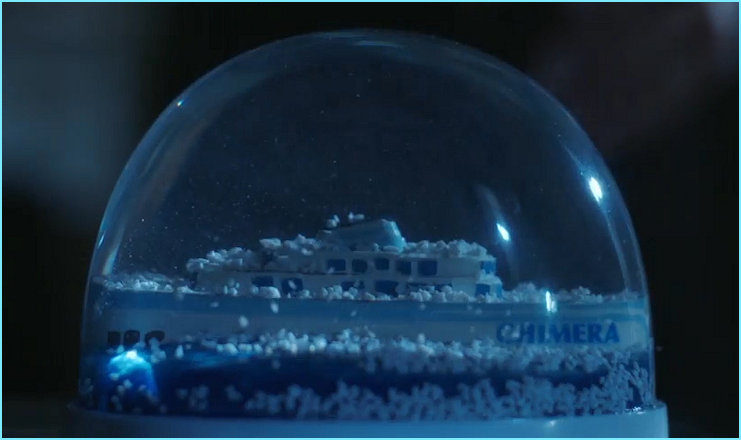
The Kalakala in a snow globe doubling up for the 'Chimera'? The character of Scully was drawn to snow globes throughout the episode.
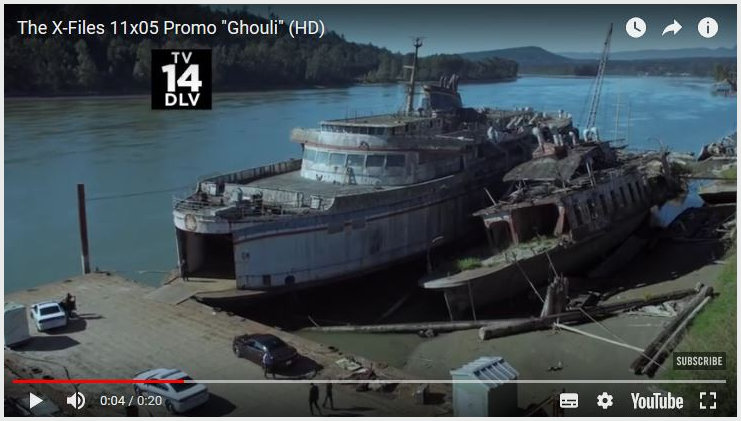
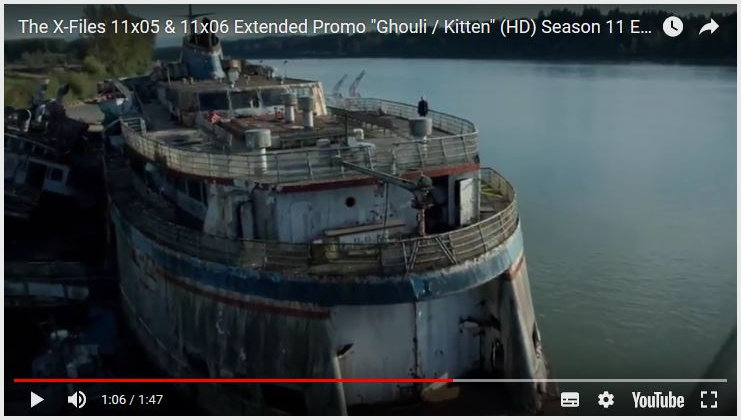
Two images from the trailers courtesy of You Tube tantalisingly mimicking bits of the Kalakala!
Page refreshed : 6th March 2018 (G)